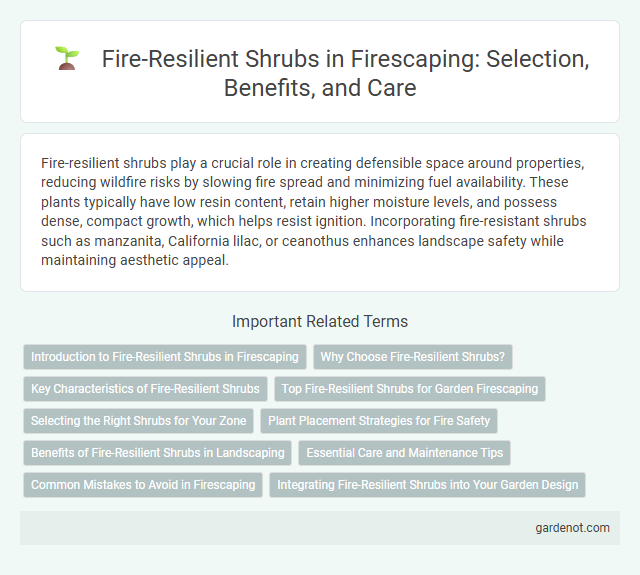Fire-resilient shrubs play a crucial role in creating defensible space around properties, reducing wildfire risks by slowing fire spread and minimizing fuel availability. These plants typically have low resin content, retain higher moisture levels, and possess dense, compact growth, which helps resist ignition. Incorporating fire-resistant shrubs such as manzanita, California lilac, or ceanothus enhances landscape safety while maintaining aesthetic appeal.
Introduction to Fire-Resilient Shrubs in Firescaping
Fire-resilient shrubs play a crucial role in firescaping by reducing wildfire risk through their low flammability and ability to withstand heat. Species such as manzanita, ceanothus, and California lilac exhibit high moisture content and minimal volatile oils, making them effective natural firebreaks. Integrating these shrubs into landscape design enhances property safety while supporting ecosystem health in fire-prone areas.
Why Choose Fire-Resilient Shrubs?
Fire-resilient shrubs reduce wildfire risk by maintaining moisture content and minimizing flammable oils, creating natural firebreaks that slow the spread of flames. These plants contribute to safer landscaping by lowering heat intensity and embers during fires, protecting property and surrounding ecosystems. Selecting species like manzanita, ceanothus, or sagebrush supports fire-adapted landscapes crucial for fire-prone regions.
Key Characteristics of Fire-Resilient Shrubs
Fire-resilient shrubs exhibit thick, moisture-rich leaves and deep root systems that enable rapid recovery after exposure to fire. These plants often have bark or stems with protective properties that resist heat damage, reducing flammability and facilitating regeneration. Their ability to sprout new growth quickly from roots or trunks enhances landscape resilience in fire-prone areas.
Top Fire-Resilient Shrubs for Garden Firescaping
Ceanothus, known for its high fire resistance, is a top choice for firescaping due to its dense, evergreen foliage and ability to retain moisture. Manzanita shrubs offer excellent fire resilience with their smooth, fire-resistant bark and low flammability, making them ideal for creating defensible spaces in fire-prone gardens. Toyon, often called California holly, provides both fire resistance and year-round greenery, contributing to a sustainable and beautiful fire-resilient landscape.
Selecting the Right Shrubs for Your Zone
Choosing fire-resilient shrubs involves selecting species native to your specific fire zone that possess high moisture content and low oil levels to reduce flammability. Incorporating plants like manzanita, ceanothus, and California lilac, known for their fire resistance, can create effective defensible space around properties. Proper placement and maintenance of these shrubs, including regular pruning and spacing, further enhance their fire resilience and protect your landscape.
Plant Placement Strategies for Fire Safety
Strategic plant placement is crucial for fire-resilient shrub integration in firescaping to minimize wildfire risk. Select fire-resistant shrubs with low resin content and arrange them in well-spaced clusters to reduce fuel continuity near structures. Maintain a defensible space by placing these shrubs at least 30 feet away from homes and using fire-resistant mulch to further inhibit flame spread.
Benefits of Fire-Resilient Shrubs in Landscaping
Fire-resilient shrubs enhance landscaping by reducing wildfire risk through their ability to resist ignition and slow fire spread. These plants retain moisture in their leaves and have low resin content, which minimizes fuel for fires and protects surrounding vegetation and structures. Incorporating fire-resilient shrubs improves property safety while maintaining aesthetic appeal and supporting local ecosystem balance.
Essential Care and Maintenance Tips
Fire-resilient shrubs require regular pruning to remove dead branches and promote healthy growth, reducing potential fuel for wildfires. Maintaining adequate spacing between plants ensures proper airflow, minimizing fire risk and enhancing shrub resilience. Watering deeply but infrequently supports strong root systems, which helps shrubs recover quickly after fire exposure.
Common Mistakes to Avoid in Firescaping
Selecting flammable shrubs like junipers or heavy resin producers near structures significantly increases fire risk in firescaping. Overcrowding plants without adequate spacing restricts airflow and promotes fire spread, undermining fire resilience. Neglecting regular maintenance such as pruning dead branches and removing dry debris contributes to fuel accumulation, compromising the effectiveness of fire-resistant landscaping.
Integrating Fire-Resilient Shrubs into Your Garden Design
Integrating fire-resilient shrubs such as manzanita, ceanothus, and toyon into your garden design reduces wildfire risk by creating defensible space with low-flammability vegetation. These drought-tolerant plants feature thick, leathery leaves and high moisture content, which slows fire spread and protects surrounding structures. Strategic placement of fire-resilient shrubs around pathways and near buildings enhances landscape safety while maintaining aesthetic appeal.
Fire-resilient shrub Infographic

 gardenot.com
gardenot.com